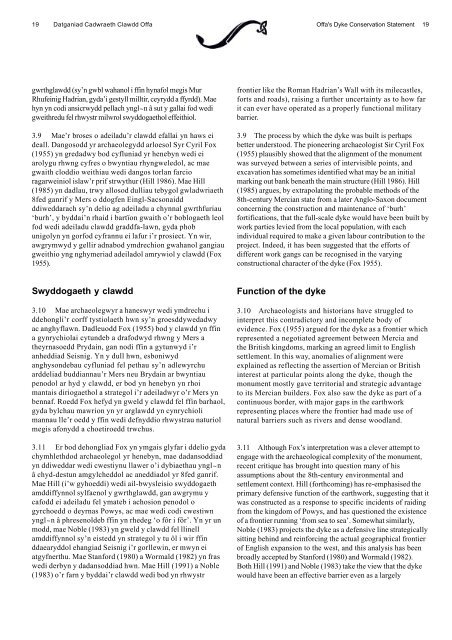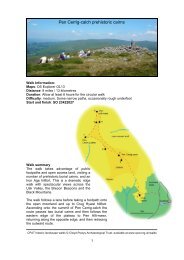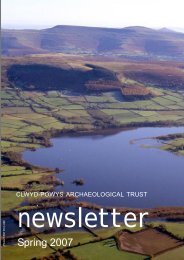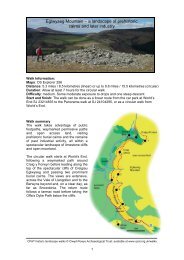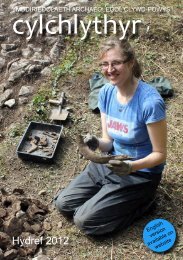Datganiad Cadwraeth Clawdd Offa Offa's Dyke Conservation ...
Datganiad Cadwraeth Clawdd Offa Offa's Dyke Conservation ...
Datganiad Cadwraeth Clawdd Offa Offa's Dyke Conservation ...
You also want an ePaper? Increase the reach of your titles
YUMPU automatically turns print PDFs into web optimized ePapers that Google loves.
19 <strong>Datganiad</strong> <strong>Cadwraeth</strong> <strong>Clawdd</strong> <strong>Offa</strong><strong>Offa</strong>'s <strong>Dyke</strong> <strong>Conservation</strong> Statement 19gwrthglawdd (sy’n gwbl wahanol i ffin hynafol megis MurRhufeinig Hadrian, gyda’i gestyll milltir, ceyrydd a ffyrdd). Maehyn yn codi ansicrwydd pellach yngl~n â sut y gallai fod wedigweithredu fel rhwystr milwrol swyddogaethol effeithiol.3.9 Mae’r broses o adeiladu’r clawdd efallai yn haws eideall. Dangosodd yr archaeolegydd arloesol Syr Cyril Fox(1955) yn gredadwy bod cyfluniad yr henebyn wedi eiarolygu rhwng cyfres o bwyntiau rhyngweledol, ac maegwaith cloddio weithiau wedi dangos torlan farcioragarweiniol islaw’r prif strwythur (Hill 1986). Mae Hill(1985) yn dadlau, trwy allosod dulliau tebygol gwladwriaeth8fed ganrif y Mers o ddogfen Eingl-Sacsonaiddddiweddarach sy’n delio ag adeiladu a chynnal gwrthfuriau‘burh’, y byddai’n rhaid i bartïon gwaith o’r boblogaeth leolfod wedi adeiladu clawdd graddfa-lawn, gyda phobunigolyn yn gorfod cyfrannu ei lafur i’r prosiect. Yn wir,awgrymwyd y gellir adnabod ymdrechion gwahanol gangiaugweithio yng nghymeriad adeiladol amrywiol y clawdd (Fox1955).frontier like the Roman Hadrian’s Wall with its milecastles,forts and roads), raising a further uncertainty as to how farit can ever have operated as a properly functional militarybarrier.3.9 The process by which the dyke was built is perhapsbetter understood. The pioneering archaeologist Sir Cyril Fox(1955) plausibly showed that the alignment of the monumentwas surveyed between a series of intervisible points, andexcavation has sometimes identified what may be an initialmarking out bank beneath the main structure (Hill 1986). Hill(1985) argues, by extrapolating the probable methods of the8th-century Mercian state from a later Anglo-Saxon documentconcerning the construction and maintenance of ‘burh’fortifications, that the full-scale dyke would have been built bywork parties levied from the local population, with eachindividual required to make a given labour contribution to theproject. Indeed, it has been suggested that the efforts ofdifferent work gangs can be recognised in the varyingconstructional character of the dyke (Fox 1955).Swyddogaeth y clawdd3.10 Mae archaeolegwyr a haneswyr wedi ymdrechu iddehongli’r corff tystiolaeth hwn sy’n groesddywedadwyac anghyflawn. Dadleuodd Fox (1955) bod y clawdd yn ffina gynrychiolai cytundeb a drafodwyd rhwng y Mers atheyrnasoedd Prydain, gan nodi ffin a gytunwyd i’ranheddiad Seisnig. Yn y dull hwn, esboniwydanghysondebau cyfluniad fel pethau sy’n adlewyrchuarddeliad buddiannau’r Mers neu Brydain ar bwyntiaupenodol ar hyd y clawdd, er bod yn henebyn yn rhoimantais diriogaethol a strategol i’r adeiladwyr o’r Mers ynbennaf. Roedd Fox hefyd yn gweld y clawdd fel ffin barhaol,gyda bylchau mawrion yn yr arglawdd yn cynrychiolimannau lle’r oedd y ffin wedi defnyddio rhwystrau naturiolmegis afonydd a choetiroedd trwchus.3.11 Er bod dehongliad Fox yn ymgais glyfar i ddelio gydachymhlethdod archaeolegol yr henebyn, mae dadansoddiadyn ddiweddar wedi cwestiynu llawer o’i dybiaethau yngl~nâ chyd-destun amgylcheddol ac aneddiadol yr 8fed ganrif.Mae Hill (i’w gyhoeddi) wedi ail-bwysleisio swyddogaethamddiffynnol sylfaenol y gwrthglawdd, gan awgrymu ycafodd ei adeiladu fel ymateb i achosion penodol ogyrchoedd o deyrnas Powys, ac mae wedi codi cwestiwnyngl~n â phresenoldeb ffin yn rhedeg ‘o fôr i fôr’. Yn yr unmodd, mae Noble (1983) yn gweld y clawdd fel llinellamddiffynnol sy’n eistedd yn strategol y tu ôl i wir ffinddaearyddol ehangiad Seisnig i’r gorllewin, er mwyn eiatgyfnerthu. Mae Stanford (1980) a Wormald (1982) yn fraswedi derbyn y dadansoddiad hwn. Mae Hill (1991) a Noble(1983) o’r farn y byddai’r clawdd wedi bod yn rhwystrFunction of the dyke3.10 Archaeologists and historians have struggled tointerpret this contradictory and incomplete body ofevidence. Fox (1955) argued for the dyke as a frontier whichrepresented a negotiated agreement between Mercia andthe British kingdoms, marking an agreed limit to Englishsettlement. In this way, anomalies of alignment wereexplained as reflecting the assertion of Mercian or Britishinterest at particular points along the dyke, though themonument mostly gave territorial and strategic advantageto its Mercian builders. Fox also saw the dyke as part of acontinuous border, with major gaps in the earthworkrepresenting places where the frontier had made use ofnatural barriers such as rivers and dense woodland.3.11 Although Fox’s interpretation was a clever attempt toengage with the archaeological complexity of the monument,recent critique has brought into question many of hisassumptions about the 8th-century environmental andsettlement context. Hill (forthcoming) has re-emphasised theprimary defensive function of the earthwork, suggesting that itwas constructed as a response to specific incidents of raidingfrom the kingdom of Powys, and has questioned the existenceof a frontier running ‘from sea to sea’. Somewhat similarly,Noble (1983) projects the dyke as a defensive line strategicallysitting behind and reinforcing the actual geographical frontierof English expansion to the west, and this analysis has beenbroadly accepted by Stanford (1980) and Wormald (1982).Both Hill (1991) and Noble (1983) take the view that the dykewould have been an effective barrier even as a largely


